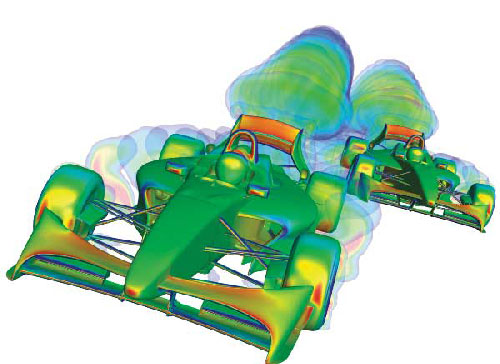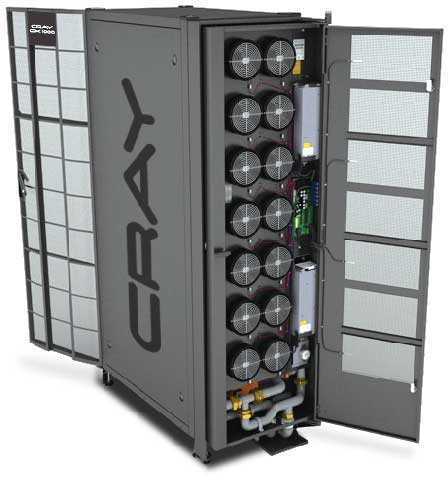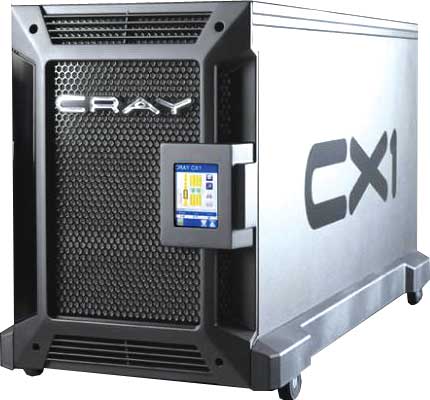Swift Engineering Races Ahead with Cluster Computing
This designer of high-performance vehicles makes a difference with its cluster.
Latest News
April 1, 2012
By Peter Varhol
Swift Engineering is a multi-disciplined engineering and manufacturing company that specializes in the design, development and manufacturing of lightweight composite structures, components and vehicles. The company is notable for producing racing cars for a variety of open-wheel racing series, including Champ Car World Series, Formula Atlantic and Formula Nippon. It also designs and manufactures critical components for aircraft and unmanned aviation vehicle (UAV) systems.
Swift is especially well known for its exacting engineering and manufacturing of critical airflow components, including wings, spoilers and control surfaces. Swift’s services include tooling and build-to-print composite manufacturing with materials such as carbon fiber, Kevlar and fiberglass.
“We started in the early 1980s, designing Formula 4 racing cars,” said Dr. John F. Winkler, Swift’s chief aerodynamicist. “In the mid-1990s, we decided to go for the big time, and began designing Formula 1. A decade later, we branched out into aviation, building new aircraft designs.”

CFD models featuring Formula race cars.
The company has always prided itself on its ability to take a project all the way through the design process. It is often presented with a concept on paper, and then takes that concept to design, analysis, testing, prototyping and actual production. The staff consists of an engineering group, administrative staff and a group of manufacturing specialists.
Cluster Beginnings
Computing has always been an important part of Swift Engineering’s design practices. In 2001, the company began using a 16-node cluster specifically for computational fluid dynamics (CFD) analysis. Two linked Linux Dell 960 workstations, with a total of eight cores and 32GB of memory, replaced this system in 2006—and increased computing power on the order of two-fold.
In conjunction with these computing resources, Swift used a dedicated wind tunnel in a building at its facility. Prospective designs were initially analyzed using CFD software, which provided some insight into their behaviors. More promising designs were prototyped in Swift’s small fabrication facility, and tested in the wind tunnel. Based on the data collected in the wind tunnel experiments, the company designers went back to the design software and made changes to improve its characteristics.
Swift Engineering produced the prototype Eclipse 400 single-engine very light jet aircraft under contract to Eclipse Aviation. It also designed and built a UAV platform. This consisted of the aircraft itself, as well as the launch and recovery systems. On the Eclipse project, speed was paramount, and Swift Engineering was able to get from paper to flight at the Oshkosh Experimental Aircraft Association gathering in seven months. Both of these projects were done primarily using the Dell 960 systems.
Using the two-PC Linux configuration, Swift Engineering continued to turn up the dial on CFD, finite element analysis (FEA), and other types of simulations, reducing the number of physical prototypes produced. This relatively conventional iterative design process resulted in world-class racing and aerospace designs, but was both costly and time-consuming.
The need to fabricate prototypes and physically test them was a slow process, especially when there were several iterative prototypes. Physical prototypes provided a solid test bed for experimentation and evaluation, but could slow down a project.
Virtual Prototypes
With the steady improvement of CFD and other analysis software available, Swift Engineering decided that the time had come to make more of a commitment to computational analysis and simulation. The company believed that it could improve the quality of designs and time to market with better up-front computational work.
As a result of its success with the Eclipse project, it didn’t take long for Swift Engineering to outgrow its Linux workstations. The increased use of simulation meant that it needed more computing horsepower. Fortunately, more powerful systems were in the process of becoming less expensive, and there were several different technologies that could fulfill their growing needs.
Swift quickly determined that the best way to get that additional computational power was through a cluster that offered a large number of processors and cores. According to Winkler, the firm knew what it was going after in a cluster solution. While such a configuration doesn’t help with largely single-threaded design computational work, it is essential for performing CFD and other simulations.
Requirements for an Engineering Cluster
As Swift Engineering made the transition to its current high-performance computing (HPC) environment, it had several challenges to overcome. One of the most significant challenges, Winkler says, was manageability.
“An HPC solution had to be simple and require minimal management,” he explains. “We’re a small design and manufacturing firm, and we have no dedicated system or network administration staff.” The company needed to be able to focus on its engineering work, rather than spend a large amount of time managing the cluster.
Performance was another important consideration. A high-performance cluster not only makes it possible to solve larger and more complex problems; it also makes possible solving the same problems in less time.
Today, Swift Engineering uses Altair’s HyperWorks suite, Metacomp Technologies’ CFD++ and Platform Computing cluster management software (Platform HPC) on its pair of Cray CX1s and Cray CX1000 HPC systems. The CX1s are entry-level systems set up as workstations, while the CX1000 incorporates dual-socket Intel Xeon 5600s that provide 18 nodes with 144 cores—essentially eight cores per node. Each node has 24GB of memory, for a total of 432GB of memory.
 |  |
|---|---|
| Swift Engineering used a pair of Cray CX1s (above, right) and a Cray CX1000 HPC system (above, left) to advance its simulations to the point where it no longer needed a dedicated wind tunnel. | |
“This system is quite small in terms of true supercomputers,” Winkler admits. “But it was sized to solve 95% of our problems in-house.” For the remaining problems, he adds, the company outsources to larger computing facilities.
One CX1 is configured as a visualization workstation, with 192GB of memory. The second CX1 has a bit more computational horsepower for FEA for structural analysis, such as crash simulation.
With Platform HPC and Cray’s CX1000 compact computing cluster, Swift Engineering was up and running on the CX1000 and the CX1s within a week. Platform provides the level of manageability needed to allocate cluster resources with an ongoing jobs queue, and to keep systems online at a high level of reliability. Together, these systems enable the CFD simulations Swift Engineering needs to take a concept and a set of performance specifications, and move from concept to design to simulation—and from there into production, more quickly than ever.
Looking ahead
Swift Engineering hasn’t entirely abandoned the use of a wind tunnel for testing designs, Winkler points out.
“We don’t need a dedicated wind tunnel anymore,” he continues. “But we will still use one on occasion, either to do a reality check on our simulations, or when we’re finalizing a design. In those cases, we’ll contract with a commercial wind tunnel to provide us the time to use.”
But a dedicated wind tunnel was expensive to support and maintain, so Swift Engineering moved beyond that expense. The company will instead use the facilities for manufacturing using composites, which better meets the evolving needs of its customers, Winkler says.
Contributing Editor Peter Varhol covers the HPC and IT beat for DE. His expertise is software development, math systems, and systems management. You can reach him at [email protected].
MORE INFO
Subscribe to our FREE magazine, FREE email newsletters or both!
Latest News
About the Author
Peter VarholContributing Editor Peter Varhol covers the HPC and IT beat for Digital Engineering. His expertise is software development, math systems, and systems management. You can reach him at [email protected].
Follow DE





